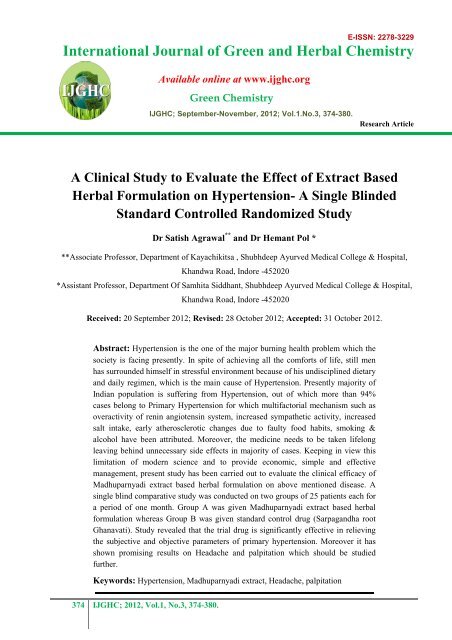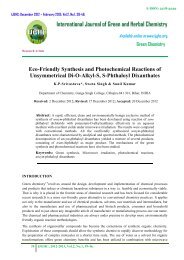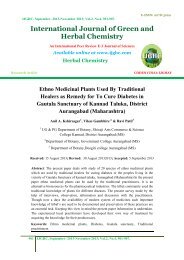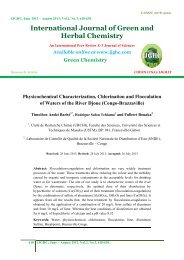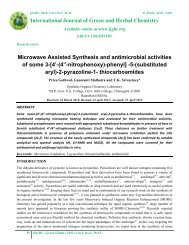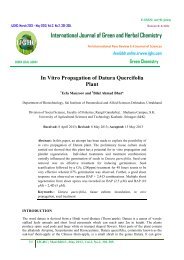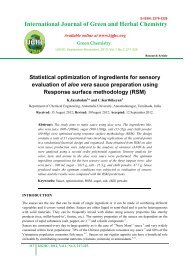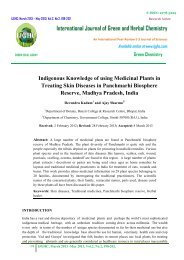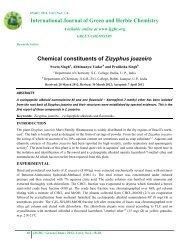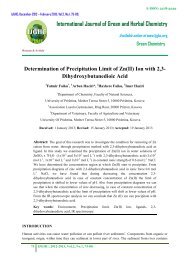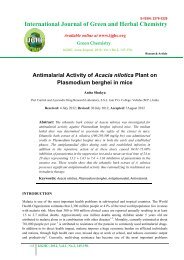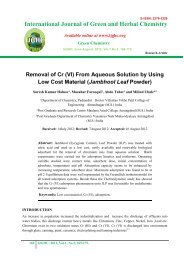A Clinical Study to Evaluate the Effect of Extract Based ... - IJGHC
A Clinical Study to Evaluate the Effect of Extract Based ... - IJGHC
A Clinical Study to Evaluate the Effect of Extract Based ... - IJGHC
Create successful ePaper yourself
Turn your PDF publications into a flip-book with our unique Google optimized e-Paper software.
E-ISSN: 2278-3229International Journal <strong>of</strong> Green and Herbal ChemistryAvailable online at www.ijghc.orgGreen Chemistry<strong>IJGHC</strong>; September-November, 2012; Vol.1.No.3, 374-380.Research ArticleA <strong>Clinical</strong> <strong>Study</strong> <strong>to</strong> <strong>Evaluate</strong> <strong>the</strong> <strong>Effect</strong> <strong>of</strong> <strong>Extract</strong> <strong>Based</strong>Herbal Formulation on Hypertension- A Single BlindedStandard Controlled Randomized <strong>Study</strong>Dr Satish Agrawal ** and Dr Hemant Pol ***Associate Pr<strong>of</strong>essor, Department <strong>of</strong> Kayachikitsa , Shubhdeep Ayurved Medical College & Hospital,Khandwa Road, Indore -452020*Assistant Pr<strong>of</strong>essor, Department Of Samhita Siddhant, Shubhdeep Ayurved Medical College & Hospital,Khandwa Road, Indore -452020Received: 20 September 2012; Revised: 28 Oc<strong>to</strong>ber 2012; Accepted: 31 Oc<strong>to</strong>ber 2012.Abstract: Hypertension is <strong>the</strong> one <strong>of</strong> <strong>the</strong> major burning health problem which <strong>the</strong>society is facing presently. In spite <strong>of</strong> achieving all <strong>the</strong> comforts <strong>of</strong> life, still menhas surrounded himself in stressful environment because <strong>of</strong> his undisciplined dietaryand daily regimen, which is <strong>the</strong> main cause <strong>of</strong> Hypertension. Presently majority <strong>of</strong>Indian population is suffering from Hypertension, out <strong>of</strong> which more than 94%cases belong <strong>to</strong> Primary Hypertension for which multifac<strong>to</strong>rial mechanism such asoveractivity <strong>of</strong> renin angiotensin system, increased sympa<strong>the</strong>tic activity, increasedsalt intake, early a<strong>the</strong>rosclerotic changes due <strong>to</strong> faulty food habits, smoking &alcohol have been attributed. Moreover, <strong>the</strong> medicine needs <strong>to</strong> be taken lifelongleaving behind unnecessary side effects in majority <strong>of</strong> cases. Keeping in view thislimitation <strong>of</strong> modern science and <strong>to</strong> provide economic, simple and effectivemanagement, present study has been carried out <strong>to</strong> evaluate <strong>the</strong> clinical efficacy <strong>of</strong>Madhuparnyadi extract based herbal formulation on above mentioned disease. Asingle blind comparative study was conducted on two groups <strong>of</strong> 25 patients each fora period <strong>of</strong> one month. Group A was given Madhuparnyadi extract based herbalformulation whereas Group B was given standard control drug (Sarpagandha rootGhanavati). <strong>Study</strong> revealed that <strong>the</strong> trial drug is significantly effective in relieving<strong>the</strong> subjective and objective parameters <strong>of</strong> primary hypertension. Moreover it hasshown promising results on Headache and palpitation which should be studiedfur<strong>the</strong>r.Keywords: Hypertension, Madhuparnyadi extract, Headache, palpitation374 <strong>IJGHC</strong>; 2012, Vol.1, No.3, 374-380.
A <strong>Clinical</strong>...Satish Agrawal and Hemant PolTable- 1: Drug compositionGuduchi stem-100mgSarphgandha root-50mgJatamansi rhizome-100mgPunarnava root-50mgShilajeet-75mgAjwain seeds-50mgNishotha root-50mgPippali fruit-25mgStandard control (active compara<strong>to</strong>r) capsule contains 500 mg Ghana <strong>of</strong> Sarpagandha root.RESEARCH METHODOLOGYType <strong>of</strong> study: Single blinded comparative study.<strong>Study</strong> site: IPD and OPD department <strong>of</strong> Shubhdeep ayurved medical college, Indore (MP).Sample size: 50 patients divided randomly in<strong>to</strong> two equal groups. Group A given trial drug whereas GroupB given control drug.Drug dosage and vehicle: 1 capsule twice daily with lukewarm water after meals.Duration <strong>of</strong> treatment: one month (examined at weekly intervals.)Dietary advice: To strictly restrict <strong>the</strong> daily intake <strong>of</strong> sour (amla), salty (lavana) and heavy (guru) diet.OBSERVATIONS &RESULTS• 70% Patients found <strong>to</strong> be hypertensive were above 40 years <strong>of</strong> age.• 60% Patients were fond <strong>of</strong> salty & spicy diet.• Out <strong>of</strong> 50 patients 30 patients (60%) belongs <strong>to</strong> service class.• Out <strong>of</strong> 50 patients, 35 patients (70%) were male.• Regarding prevalence <strong>of</strong> symp<strong>to</strong>ms, Dyspnoea on routine work was found in 82%,Headache & palpitation in 80%, Vertigo in 78% & Fatigue in 66% patients.Table- 2: Paired‘t’ Test for Subjective parameters – group AS.No. Symp<strong>to</strong>m N B.T. A.T. Diff. % SD SE ± ‘t’ PMean Mean Mean Relief1 Headache 20 1.65 0.5 1.15 69.69 0.587 0.131 8.76
A <strong>Clinical</strong>...Satish Agrawal and Hemant PolTable- 3: Paired‘t’ Test for Subjective parameters– Group BS.No Symp<strong>to</strong>m NB.T.MeanA.T.MeanDifferenceMean% ReliefSD ± SE ± ‘t’ P1 Headache 20 1.1 0.6 0.5 45.45 0.69 0.15 3.25
A <strong>Clinical</strong>...Satish Agrawal and Hemant PolTable-7: Unpaired‘t’ test for Objective parameters.No. Symp<strong>to</strong>m Group A Group B T D.F. PN Mean±SEM N Mean±SEM1 Sys<strong>to</strong>lic 25 34 ± 1.815 25 25.6 ± 0.98 4.073 48
A <strong>Clinical</strong>...Satish Agrawal and Hemant PolThe trial drug is supposed <strong>to</strong> have specific effect on circula<strong>to</strong>ry and nervous system so as <strong>to</strong> relieve <strong>the</strong>pathogenesis <strong>of</strong> hypertension. Ajwain 4 and Pippali 5 pacify Kapha deposited on vessel wall and seem <strong>to</strong>work on Sanchaya, Prakopa and Prasara stage <strong>of</strong> Kriyakala. Shilajeet 6 and Pippali exerts Sro<strong>to</strong>shodhanakarma through Rasayana property and seems <strong>to</strong> work on Sthana sanshraya stage <strong>to</strong> curette <strong>the</strong> Kaphadeposited on vessel wall. It is evident that this stage occurs at <strong>the</strong> site <strong>of</strong> disease. Punarnava 7 andNishotha 8 exert diuretic action through Shothhara karma. Guduchi 9 helps in pacifying remaining Dosha.Jatamansi 10 and Sarpgandha 11 <strong>to</strong>ge<strong>the</strong>r help <strong>to</strong> reduce sympa<strong>the</strong>tic hyperactivity and nervous fac<strong>to</strong>rsresponsible for hypertension. In o<strong>the</strong>r words <strong>the</strong>y exert Manodoshhara karma. It has been proved bymodern researches also.Finally it can be concluded that <strong>the</strong> drug under study has shown enthusiastic results in reducing <strong>the</strong> overallvalue <strong>of</strong> blood pressure. 64% patients got effectively cured, 24% got well cured and 12% got fairly cured.Regarding symp<strong>to</strong>matic relief, out <strong>of</strong> 25 patients 8 showed more than 75% relief, 9 showed more than50% relief , 7 showed more than25% relief and only 1 patient showed less than 25% relief in overallsymp<strong>to</strong>ms (Table 9). No significant side effects have been reported in any subject.To conclude, <strong>the</strong> drug under trial has shown highly promising results in treating hypertension, whichshould be assessed on larger population. It has also opened <strong>the</strong> way for treatment <strong>of</strong> o<strong>the</strong>r disease entitywhich is result <strong>of</strong> undisciplined dietary and daily regimen <strong>of</strong> modern society.ACKNOWLEDGEMENTWe greatly acknowledge respected Principal, hospital staff & our colleagues, Shubhdeep AyurvedMedical College & hospital Indore for extending <strong>the</strong>ir every possible help & well wishes <strong>to</strong>complete <strong>the</strong> above study.REFERENCES1. Brahman Tripathi, Charak Samhita (vol-1), Sutrasthana, Trishothiya Adhyay, Shloka no. 18/44,Varanasi Chaukhambha Surbharati Prakashan, 2009, page 378.2. Brahman Tripathi , Charak Samhita (vol-2), Chikitsasthana, Vatvyadhi Adhyay, Shloka no. 28/59,Varanasi Chaukhambha Surbharati Prakashan, 2009, page 948.3. Brahman Tripathi , Charak Samhita (vol-1), Sutrasthana, Dirghamjivitiya Adhyay, Shloka no.1/66, Varanasi Chaukhambha Surbharati Prakashan, 2009, page 36.4. Dr. K.C. Chunekar, commentary edited by G.S. Pandey, Bhavaprakash Nighantu HaritkyadiVarga, Shloka 76, Varanasi Chaukhambha Bharati Academy, reprint 2004, page 25.5. Dr. K.C. Chunekar, commentary edited by G.S. Pandey, Bhavaprakash Nighantu HaritkyadiVarga, Shloka 58, Varanasi Chaukhambha Bharati Academy, reprint 2004, page 15.6. Indradev Tripathi, Raj Nighantu Guduchyadi , Varga Shloka 73, Varanasi, ChaukhambaKrishnadas Academy, 2003, page 433.7. Dr. K.C. Chunekar, commentary edited by G.S. Pandey, Bhavaprakash Nighantu GuduchyadiVarga, Shloka 231, Varanasi Chaukhambha Bharati Academy, reprint 2004, page 422.379 <strong>IJGHC</strong>; 2012, Vol.1, No.3, 374-380.
A <strong>Clinical</strong>...Satish Agrawal and Hemant Pol8. Dr. K.C. Chunekar, commentary edited by G.S. Pandey, Bhavaprakash Nighantu GuduchyadiVarga, Shloka 194, Varanasi Chaukhambha Bharati Academy, reprint 2004, page 397.9. Indradev Tripathi, Raj Nighantu Guduchyadi, Varga Shloka 17-18, Varanasi, ChaukhambaKrishnadas Academy, 2003, page 31.10. Database on Medicinal plants used in Ayurveda, Volume 7 CCRAS, New Delhi, 2005, p136-139.11. Database on Medicinal plants used in Ayurveda, Volume 7 CCRAS, New Delhi, 2005, p387- 390.*Correspondence Author: Dr Satish Agrawal; Associate pr<strong>of</strong>essor,Department <strong>of</strong> Kayachikitsa , Shubhdeep Ayurved Medical College & Hospital,Khandwa Road, Indore -452020380 <strong>IJGHC</strong>; 2012, Vol.1, No.3, 374-380.


